
We begin with two recent voices in Cordite Poetry Review.
‘There is an assumption that real art only comes from the city,’ writes Winnie Siulolovao Dunn in her 2017 essay, ‘FOB: Fresh off the Books’. Dunn is writing about the stigma of hailing from both Mt Druitt and Tonga. For the young Dunn, the ethnically diverse Western Suburbs of Sydney seem far removed from any cultural centre. Indeed, as Dunn recounts, it took her twenty-one years to write and own ‘the literature of being a Fob in Mounty County.’
The second voice is Corey Wakeling’s, and it comes from his brilliantly provocative review of Puncher & Wattmann’s Contemporary Australian Poetry. Here, Wakeling argues that ‘the suburban is a preeminent register of the Australian contemporary’ and that ‘much Australian poetry already seems embedded in the suburban condition.’ For Wakeling, the huge CAP volume is a testament to the various ways that contemporary poetry is implicated in or grappling with notions and legacies of suburbia.
Suburbia is often perceived to be artistically peripheral and yet it is also entrenched as the focal point of Australian cultural hegemony. After all, Australia has been the most suburban nation on earth since the late nineteenth century. This is part of the reason that works like Courtney Barnett’s song ‘Depreston’ or Luke Carman’s novel An Elegant Young Man possess such resonance, for both works map edges and centres. And both are aware of those tectonic cultural forces that pull in competing directions. Yet the valency of suburbia also lies in the paradoxes of its own definition (the OED defines suburbia as ‘just beyond or just within’ the boundaries of a city) as well as in those contradictory reasons for which suburbs are criticised (e.g. they are too safe / dangerous, homogenous / diverse, materialistic / poor, conformist / law-breaking, mainstream / marginal, boring / chaotic).
When all of the above meets the charged, volatile nature of poetic expression (language which is itself also mysteriously ‘beyond or within’ the polis), we end up with Cordite 84: SUBURBIA. As Brigid Rooney has pointed out, ‘the lived experience, spatial contours and cultural demographics of contemporary suburbia are in flux.’ And it seems to us that poetry is uniquely placed to engage with those constantly changing modes of everyday existence. Indeed, if Andrew McCann is right, and anxieties about suburbia aren’t just anxieties about everyday life, but they are ‘anxieties about the “everyday” itself as an experiential category,’ then poetry is a remarkably apt way to register this heightened awareness. For instance, we see it in the colloquial saturation of specific Annandale spaces in Robin Eames’s ‘curb cut cartography,’ or the exquisite claustrophobia of Ella Jeffreys’s ‘Crescent Road.’ We hear it in the disrupted voice of the mother in Kerry Shying’s ‘Neonate,’ or the apocalyptic postcolonial breathing of Scott Patrick Mitchell’s ‘birak.’
The various types of suburb also orient us toward notions of form and shape, with their planning and sprawl, their pockets of fastidiousness and zones of neglect, their onramps and arterials, backstreets, boulevards, laneways and cul-de-sacs. And, like suburbia, contemporary poetry is marked by encounters between formal inventiveness and certain inherited arrangements. In this issue, Philip Thiel’s ‘Chadstone Sonnet’ offers the proprietary intensity of store names within the frame of the Elizabethan Sonnet. Tess Pearson’s ‘Household Ripening’ uses the pantoum form to explore ‘the dance of avoidance’ provoked by interminable housework. Elsewhere, there are erasure poems made from Christina Stead’s The Man Who Loved Children (Michele Seminara), poems in the shape of car-yard bunting (Mike Ladd), and even acrostics incorporating lines from the Petshop Boys (Stuart Barnes).
The poems in this issue are grounded in a variety of suburban experiences and locations in suburbs around Australia, as well as in North America, Asia and Europe, engaging with a range of themes, ideas and emotions. Brendan Ryan’s ‘View of the New Estates’ tackles the tension that has existed between suburbia and nature ever since the first bulldozer cleared the ground for the first subdivision. Mindy Gill’s poem celebrates suburban tranquillity, Lyn McCredden delivers a tale of intra-suburban prejudices, Anne Casey sings a wry and joyful hymn to a domestic suburban weekend, and Andrew Burke pays tribute to the iconic Hills Hoist.
It is our hope that this collection of poems represents a diverse and compelling cross-section of Australian and international suburban writing. Throughout the selection process, we were delighted, humbled, excited and slightly overwhelmed by the sheer volume of excellent pieces we received (the number of poems submitted approached two thousand). The massive response to our request for poems on the theme of suburbia testifies to the importance and ubiquity of suburbia in contemporary writing. The poetic responses to suburbia ranged from celebratory to disparaging, revealing both the pervasive influence of the anti-suburban tradition in Anglophone (especially Australian) literature and the desire and ability of many contemporary writers to abandon, dismantle, sidestep, reconfigure or ignore reductive stereotypes of suburbia. However, perhaps this kind of (poetic) population growth and sprawl is appropriate and expected for an issue on contemporary suburbia …













